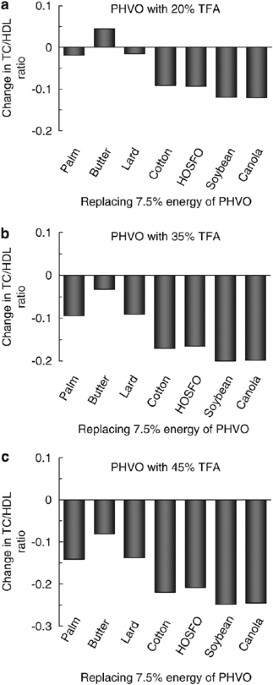Quantitative effects on cardiovascular risk factors and coronary heart disease risk of replacing partially hydrogenated vegetable oils with other fats and oils
Quantitative effects on cardiovascular risk factors and coronary heart disease risk of replacing partially hydrogenated vegetable oils with other fats and oils"
- Select a language for the TTS:
- UK English Female
- UK English Male
- US English Female
- US English Male
- Australian Female
- Australian Male
- Language selected: (auto detect) - EN
Play all audios:
Reduced consumption of trans-fatty acids (TFA) is desirable to lower coronary heart disease (CHD) risk. In practice, partially hydrogenated vegetable oils (PHVO) that contain both TFAs and
other fatty acids are the unit of replacement and could be replaced with diverse alternative fats and oils. We performed quantitative estimates of CHD effects if a person's PHVO consumption
were to be replaced with alternative fats and oils based on (1) randomized dietary trials and (2) prospective observational studies.
We performed meta-analyses of (1) the effects of TFAs on blood lipids and lipoproteins in controlled dietary trials and (2) associations of habitual TFA consumption with CHD outcomes in
prospective cohort studies. On the basis of these results and corresponding findings for saturated fatty acids (SFA), cis-monounsaturated fatty acids (MUFA) and cis-polyunsaturated fatty
acids (PUFA), we calculated the effects on CHD risk for replacing 7.5% of energy from three different PHVO formulations (containing 20, 35 or 45% TFAs) with butter, lard, palm or vegetable
oils.
In controlled trials, each 1% energy replacement of TFAs with SFAs, MUFAs or PUFAs, respectively, decreased the total cholesterol (TC)/high-density lipoprotein cholesterol (HDL-C) ratio by
0.31, 0.54 and 0.67; the apolipoprotein (Apo)-B/ApoAI ratio by 0.007, 0.010 and 0.011; and lipoprotein (Lp)(a) by 3.76, 1.39 and 1.11 mg/l (P
Trending News
On Faith: Nuns Risk All in ‘Radical Grace’In 2012 the Vatican issued an official censure of American nuns saying that feminism is incompatible with Catholicism an...
Former WA mare wins NWTLHA Mares Feature at BurnieAdLocal SportLocal FootyLocal SportLocal FootyNews HomeNewsSportCommunityTributes & FuneralsClassifiedsExplore TravelEnt...
Republican Abortion Rights Activist Reacts To Kennedy Retirement | WFAE 90.7 - Charlotte's NPR News SourceRepublican Abortion Rights Activist Reacts To Kennedy Retirement Published June 30, 2018 at 6:08 PM EDT Facebook Twitter...
Airbus pledges counter-punch to new Boeing mid-sized jetAirbus hinted on Tuesday at a price battle to counter a possible new Boeing aircraft in the middle of the jet market, pr...
Outlander cast share hilarious Sam Heughan impressions with some failing miserably - Daily RecordOutlander cast share hilarious Sam Heughan impressions with some failing miserablyFan favourites including Caitriona Bal...
Latests News
Quantitative effects on cardiovascular risk factors and coronary heart disease risk of replacing partially hydrogenated vegetable oils with other fatsReduced consumption of trans-fatty acids (TFA) is desirable to lower coronary heart disease (CHD) risk. In practice, par...
Life Is No. 1; Then Comes Wrestling : Marco Quinones Is Father, Husband, Student, AthleteSAN DIEGO — After a full day of classes, wrestling practice and a part-time job laying cement for his uncle, Marco Quino...
Heavy trucks will be billed by glonassBeginning with 2015, owners of heavyweight trucks weighing more than 12 tons will pay 3.7 rubles per kilometer travelled...
Javascript support required...
News you might have missed: #freebritney and north korean ghost shipsA LOT of stuff happened this week, and it's not possible to keep up with everything. Here's a few things you m...
